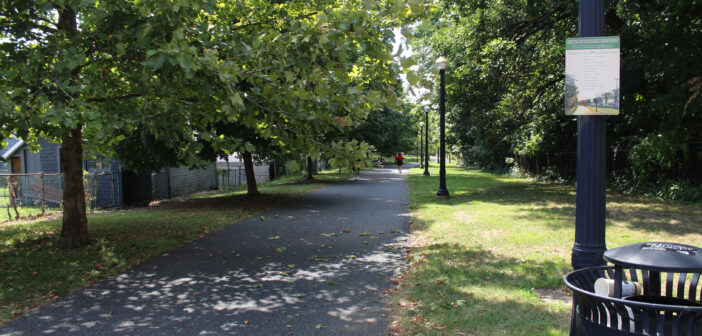Green spaces are being replaced by buildings and pavement, which have surfaces that absorb more heat than natural land cover, ultimately increasing heat-related illness and energy costs.
According to the 2021 State of the Lehigh Valley, urban heat islands are parts of cities that are “consistently warmer, in terms of surface temperature, air temperature, or both,” than nearby urban, suburban and rural areas.
As a result, cities and residential spaces with more pavement often have higher temperatures than those with more green space. Communities with higher populations of racial minorities and lower-income households, like some in the Lehigh Valley, are disproportionately affected.
Justice starts on the South Side
According to the report, much of South Side Bethlehem qualifies as an “environmental justice community,” meaning it is more exposed to environmental risks, such as heat islands.
Karen Pooley, a political science professor at Lehigh and author of “Environmental Injustice in Allentown,” featured in the report, points to excess heat and limited access to green space as the most apparent issues concerning the Bethlehem area.
The 2021 City of Bethlehem Climate Action Plan shows areas of South Bethlehem surrounding Lehigh University’s campus qualify as urban heat islands, with temperatures significantly hotter than Bethlehem’s average.
According to the plan, Bethlehem’s average number of days over 90 degrees are expected to increase from 12 days per year to 39 days in a near-term high warming scenario.
Santoro said Bethlehem is the first city in the Lehigh Valley to include aspects of environmental justice in its climate plan.
“(Environmental justice) is a huge topic related to climate change happening on a global scale that can really quickly become very intimidating,” Pooley said. “You wonder, ‘What on earth can any one person possibly do to influence this?’ But, when you think about how it is that we interact with these things on a neighborhood scale…it is an important way to intervene.”
According to the State of the Lehigh Valley report, more than 17,000 Bethlehem residents live farther than a 10-minute walk away from a park, and the Lehigh Valley has some of the highest levels of indoor residential radon gas across the country.
“My hope is that as they have this massive document — and by massive I mean something that took dozens of experts and hundreds of citizens a long time to put together and has countless fantastic ideas in it — to make sure that stuff hits the ground,” Pooley said.
An alliance for sustainable communities
Peter Crownfield is the internship coordinator at the Alliance for Sustainable Communities Lehigh Valley and editor of the group’s Sustainable Lehigh Valley booklet. He said he did not want to pursue sustainability professionally while attending Dartmouth College. Instead, he stuck to simple, individual efforts, such as growing his own food.
However, after being contacted in 2002 by concerned Lehigh Valley residents, he helped found the Alliance for Sustainable Communities.
Since he became the organization’s internship coordinator, more than 150 students have been able to contribute to the group’s work. By working with students, he has become more inspired to find answers to the questions they may have.
As co-author of “The Future of Environmental Justice,” within the 2021 report, Crownfield thinks future generations will play a large role in environmental justice. He feels as though most of the Western world is not paying enough attention to the needs of our ecosystems.
“The typical (term), which I call ‘environmental equity,’ is not environmental justice,” Crownfield said. “Justice is the noun here, so it should involve justice, not just equality.”
Now, he also works with the alliance to publish the Sustainable Lehigh Valley Booklet every six months to a year.
Since 2004, the alliance has published a directory of organizations and professionals who promote sustainability in the Lehigh Valley, alongside essays and creative works to engage readers in a relevant topic that can be hard to visualize.
“Even now that most people agree that there’s climate change, they don’t see it coming quickly,” Crownfield said. “It’s like if there’s a tsunami coming — no one knows it and everything’s calm until it hits. Well, this is going to hit.”
Kate Jackson, a professor in Lehigh’s College of Health, echoed Crownfield’s sentiment.
“To see real, true environmental justice, we need all forms of justice,” Jackson said. “We would need to think about economic justice, employment, housing justice and affordability, and educational justice and making sure these resources are equitable. Policy helps, but policy is not enough.”
Janine Santoro, Bethlehem’s director of equity and inclusion, leads the city’s Environmental Justice Steering Committee composed of professors, residents and local activists.
After presenting its goals in April, the committee is now focusing on creating a neighborhood council composed of people most at risk.
Crownfield said the environment should be discussed publicly every week by someone in office, whether that be the mayor or a member of the Environmental Justice Steering Committee.
“They do not understand that understanding it is not enough,” he said. “They have to do something, and if that makes them unpopular with certain people, then, oh well.”
Santoro said when the subject of climate change is discussed, people think of nature and climate rather than the immediate impact these things have on frontline communities. These communities consist of residents of low to moderate incomes who are majority Black, Indigenous and people of color.
In the Lehigh Valley, these communities are segregated. According to data from the 2020 Census, the Lehigh Valley has a high level of residential segregation, ranking 27th out of more than 400 metropolitan areas in terms of Hispanic-white segregation.
Santoro’s roles are intersectional — addressing issues of environmental justice as it relates to equity and inclusion.
Santoro said being conscious of not further burdening frontline communities is at the forefront of the committee’s agenda, as well as encouraging authentic participation.
A hyperlocal approach
“We want to create (policy) that is meaningful, and where the people feel like they can see tangible results from what they say to the implementation of these initiatives,” Santoro said. “It is more meaningful to talk about these things in a hyperlocal way.”
She said targeting residents as closely as their local blocks will help the Environmental Justice Steering Committee engage with them on a hyperlocal level.
The need for hyperlocal approaches is recognized between neighboring cities. While their issues may overlap, resources vary, shifting mitigation techniques.
Pooley looks comparatively at Philadelphia to see how policymakers are developing neighborhoods.
“(It’s about) thinking about transforming vacant lots that may be a negative because they are not well cared for, if there’s a lot of trash and debris in them,” Pooley said, “and shifting those into spaces that are just calm, controlled green spaces in a neighborhood and how powerful those kinds of shifts are can be.”
While she said these changes may seem obvious, there was an underappreciation for the connection between green space and mental health before cities began implementing greenery.
Through watching cities rethink how they approach community development and address quality of life concerns, Pooley said she has seen a learning curve.
She said smaller-scale, hyper localized interventions can have a big impact and will be most beneficial in creating a more environmentally-just version of Bethlehem.
The responsibility to enact change
Pooley advises policymakers to make attempts to “move the needle” when making noticeable changes for residents. She believes thoughtful and strategic investments will best enhance an environment.
“We haven’t solved the problem of climate change with these things, but we have improved people’s physical and mental well-being, and we have addressed some of the most severe consequences of things like heat island effects,” Pooley said. “Cities are used to (building) roads, to filling potholes, doing certain things. And this is going to require something different.”
Jackson noticed there can be contentious views on sustainability, including green design, reduction of consumption, preserving greenspaces and environmental justice.
As a former social worker, policy director and community organizer, Jackson said she has always been interested in equity and has been able to see firsthand how the different parts of someone’s environment, as well as structural inequality, impact their ability to thrive.
She previously worked within a community in Camden, New Jersey, which shows similarities to South Bethlehem. Here, she helped to mitigate environmental injustice in their neighborhoods and learned more about the environment’s impacts on public health.
Both cities have similarly high rates of particulate matter in the air that exacerbate chronic disease. Both are also home to a predominantly Hispanic population. Jackson said most health disparities appear due to racial discrimination and unequal access to well-paying jobs.
She said she was drawn to the College of Health because of its innovative, community-centered outlook.
“A lot of environmental injustice is often silent,” Jackson said. “We may not be actively redlining any longer, but there’s a long lasting impact of the policy of redlining of segregated neighborhoods and resources…we need to go back, know the history of why our communities were built and why, and how different systemic inequities came to be, and un-design them.”
Jackson said Lehigh recognizes the need for environmental justice through its sustainability plan.
“We, as a university, need to track our impact on the local community,” Jackson said. “We know there’s high rates of particulate matter, so where is that coming from? And how much of that could be coming from Lehigh? And what are ways in which we can reduce our impact on the local community?”
By implementing solar power and electric campus vehicles, as well as encouraging students to study the topic, Jackson said Lehigh is trying to help navigate the issue. She said Lehigh can also listen to residents who can immediately speak on existing inequities.
Jackson said a resident living in an environmental justice zone can describe the experience in detail she would never understand. She said research must be guided by these residents, or else it is not meaningful nor effective.
“If you are already worried about thinking about employment, housing and food, thinking about particulate matter in the air which is invisible is not always going to be their priority,” Jackson said. “That is why it is our responsibility to fight to get to the root cause of that.”






Comment policy
Comments posted to The Brown and White website are reviewed by a moderator before being approved. Incendiary speech or harassing language, including comments targeted at individuals, may be deemed unacceptable and not published. Spam and other soliciting will also be declined.
The Brown and White also reserves the right to not publish entirely anonymous comments.